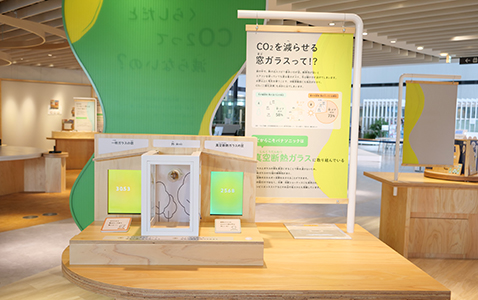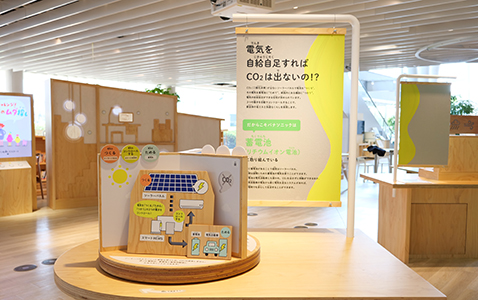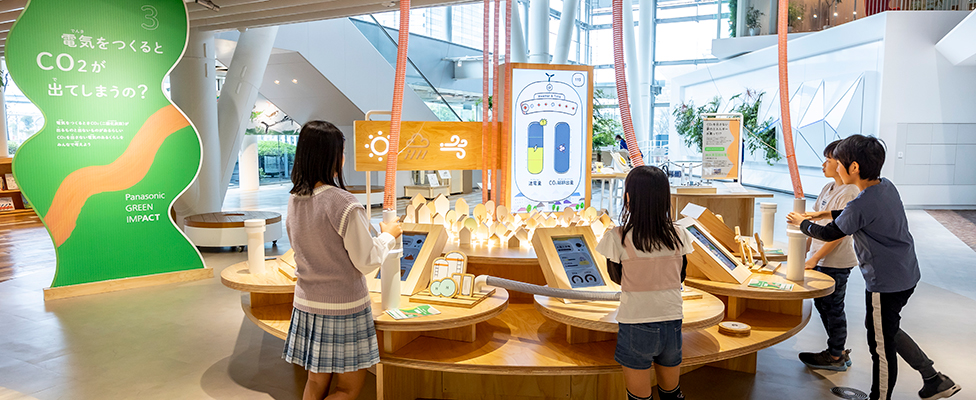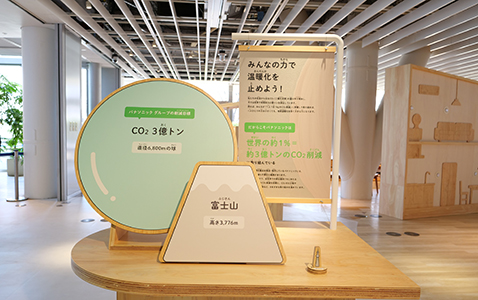Reduction of CO2 emissions
In the "Reduction of CO2 emissions" area, visitors learn how much CO2 is emitted in society and our daily lives, the types and methods of power generation, and the features of renewable energy.
Through a hands-on experience at the exhibition, we approach the adoption of various methods of generating power, efficient electricity use, and lifestyles that emit less CO2.
What are the causes of CO2 emissions?

It is said that we emit CO2 (carbon dioxide) simply just we live.
Let's study when and how much CO2 we emit.
Children can learn that we emit CO2 in our daily lives and become aware of the amount of CO2 emissions
that cannot be seen with our own eyes.
By 2050, Panasonic Group aims to create impact that reduces CO2 emissions by more than 300 million tons, or about 1% of the current total global emissions, in accordance with the Panasonic Group's long-term environment vision, Panasonic GREEN IMPACT. Visitors can also experience the scale of the impact.
Let's work together to stop global warming!
The amount of CO2 (carbon dioxide) emitted from our daily lives and activities have) been increasing year by year. Currently, 36.3 billion tons of CO2 has been emitted in the world per year.
For example, if each of us makes efforts to reduce CO2 emissions by 1 kg every day, even if our individual efforts are small, they can become a major force for preventing global warming.
Therefore, Panasonic Group has been making efforts to reduce CO2 emissions by 300 million tons, or about 1% of the current global emissions in total.
Panasonic Group, which manufactures and sells home appliances and electronic devices around the world, has a responsibility and an obligation to reduce CO2 emissions.
With the aim of reducing CO2 emissions by 300 million tons, or about 1% of the current total global emissions toward 2050, Panasonic Group is promoting a variety of initiatives, including the construction of zero-CO2 factories and development of energy-efficient products.
Can't we reduce CO2 emissions if we will continue our current lifestyles?

In order to reduce CO2 (carbon dioxide) emissions,
it is important to use energy effectively throughout our home as well as our life.
Let's study effective use of energy.
Here, children can play a game in which they look for energy waste in their home.
They become aware of energy waste in everyday life and the importance of reducing CO2 emissions.
They learn that CO2 emissions can be reduced with efficient energy use at home and in everyday life
instead of simply enduring discomfort and inconvenience or reducing waste.

What kind of windowpane can reduce CO2 emissions?
Windows are the greatest source of heat in and out of a house.
Poorly insulated windows allow heat to penetrate into rooms in summer and escape from rooms in winter, even when using air-conditioners.
The overuse of electricity will place a burden on air-conditioners and lead to unnecessary emissions of CO2 (carbon dioxide).
Therefore, Panasonic Group has been developing vacuum insulated glass.
Heat is retained by creating a vacuum space between two glass sheets, which provides 10 times the insulation of a single sheet of glass, thereby reducing energy consumption throughout the house.
In addition to being used for windows in the house, this type of glass can also be applied to refrigerated and frozen display cases, contributing to the energy-saving operation of commercial facilities such as convenience stores.

If we are energy self-sufficient, will it stop CO2 emissions?
Energy self-sufficient homes are in demand. In these homes, electricity is CREATED from solar power without emitting CO2 (carbon dioxide), STORED in storage batteries, and USED to electric equipment.
The automated control of these three functions will achieve effective energy savings throughout the house and add comfort to people's lives.
For this reason, Panasonic Group is working to spread the use of storage batteries (lithium-ion batteries).
With storage batteries at home, one can use solar power during day time and the power accumulated in storage batteries at night time.
Storage batteries are also used in electric vehicles, enabling people to travel without emitting CO2. Moreover, if they are equipped with a system to supply power to the house from the vehicle's batteries, then they can live with peace of mind even during power outages caused by disasters.
Does power generation always emit CO2?

It is said that some of power generation processes emit CO2 (carbon dioxide) and others do not.
Let's study lifestyles with electricity free from CO2 emissions.
Here, children can play a game in which they generate electricity in power plants
by using water, thermal, wind, and solar power, and pure hydrogen fuel cells, and transmit it to our towns.
It is not enough to simply transmit electricity. They have to transmit electricity that emits less CO2 and select the most suitable power plant depending on the situation since weather conditions change during the game.

What is hydrogen, which is dream energy that does not emit CO2?
A large proportion of electric power used in Japan has been generated by thermal power plants dependent on fossil fuels that emit CO2 (carbon dioxide) during combustion.
Hydrogen is expected to be a position as the next-generation energy that does not emit CO2.
It is attracting attention as the ultimate energy source since it can be derived from a variety of resources, including water.
Therefore, Panasonic Group is working on development of pure hydrogen fuel cell generators.
A pure hydrogen fuel cell generator is a small power plant that causes a chemical reaction between hydrogen and oxygen in the ambient air and uses the electric power and heat generated during the process.
Large-scale power generation becomes possible by connecting multiple these fuel cells. Panasonic Group is conducting a demonstration experiment to operate its factory with fuel cells that can generate enough electricity to power 900 households.

Photovoltaic power generation may be installed in any location.
Many of popular photovoltaic generators have limitations in terms of scale and shape. Large spaces and new locations will be required to enable large-scale power generation.
Furthermore, the construction of photovoltaic generators puts a burden on the environment since deforestation may be required to ensure that the sunlight reaches the panels.
For this reason, Panasonic Group has been developing perovskite solar cells!
The next-generation solar cells use an ink-like coating material that generates power where it is painted.
The installation of photovoltaic generators was difficult on building walls and windows in past. Panasonic Group has been developing perovskite solar cells that can be used in such locations. We are aiming to contribute to energy saving in commercial facilities and offices in urban areas.

